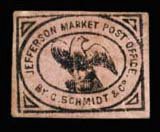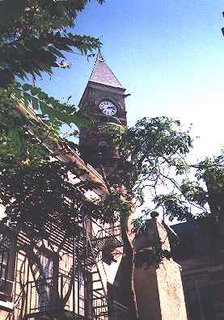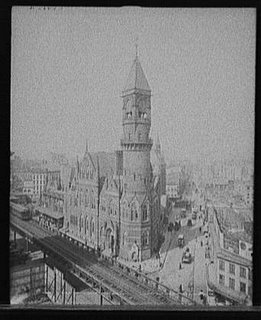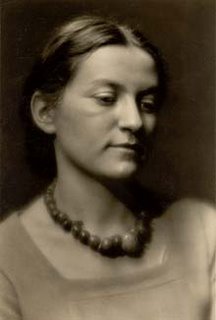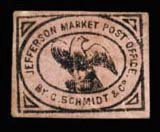Jefferson Market: January 1901
Newsboys around Jefferson Market had a hallelujah-for-hot-headlines bonus day when the demise of Murray Hall [a cigar-smoking bail bondsman who served that courthouse] revealed a secret: "he" had been a female. Here's the article that appeared in The New York Times, January 19, 1901:
MURRAY HALL FOOLED MANY SHREWD MEN
How for Years She Masqueraded in Male Attire.
HAD MARRIED TWO WOMEN
WAS A PROMINENT TAMMANY POLITICIAN AND ALWAYS VOTED — SENATOR MARTIN ASTONISHED.
Murray H. Hall, the woman who masqueraded as a man for more than a quarter of a century, and the secret of whose sex came out only after her death last Wednesday night at 145 Sixth Avenue [located then between West 10th - 11th Streets], was known to hundreds of people in the Thirteenth Senatorial District, where she figured quite prominently as a politician. In a limited circle she even had a reputation as a “man about town,” a bon vivant, and all-around “good fellow.”
• • She was a member of the General Committee of Tammany Hall, a member of the Iroquois Club, a personal friend of State Senator “Barney” Martin and other officials, and one of the most active Tammany workers in the district.
• • She registered and voted at primaries and general elections for many years, and exercised considerable political influence with Tammany Hall, often securing appointments for friends who have proved their fealty to the organization—never exciting the remotest suspicion as to her real sex.
• • She played poker at the clubs with city and State officials and politicians who flatter themselves on their cleverness and perspicacity, drank whisky and wine and smoked the regulation “big black cigar” with the apparent relish and gusto of the real man-about-town.
• • Furthermore, Murray Hall is known to have been married twice, but the woman to whom she stood before the world in the attitude of a husband kept her secret as guardedly as she did.
• • The discovery of “Murray Hall’s” true sex was not made until she was cold in death and beyond the chance of suffering humiliation from exposure. She had been suffering from a cancer in the left breast for several years, as Dr. William C. Gallagher of 302 West Twelfth Street, who attended her in her final illness, discovered; but she abjured medical advice for fear of disclosing her sex, and treated herself. When she felt that life was at a low ebb she sent for Dr. Gallagher, the awful fear of exposure being supplanted by the dread of death. He made an examination and found that the cancer had eaten its way almost to the heart, and that it was a matter of only a few days, when death must ensue.
• • He kept this information from the patient, fearing the shock might hasten death. He deceived himself, for “Murray Hall” knew as well as Dr. Gallagher that the end was near. In years gone by, from time to time, "Murray Hall' had purchased volume after volume of works on surgery and medicine until she possessed a good medical library. Those books were studied, and the knowledge gleaned, no doubt, served to a good purpose in avoiding detection.
• • Three months ago most of this library was sold to C. S. Pratt, a book seller at 161 Sixth Avenue [near West 11th Street then]. The books found a ready sale among Mr. Pratt’s customers, and there was only one left in his shop when a reporter called there yesterday. This was a volume on “The Science and Art of Surgery,” by John Eric Erichsen, and was published in 1881. The flyleaf of the book contained this inscription written a feminine hand in a lead pencil. “Cella Lin Hall, 128 Second Avenue, N.Y.” Cella was the name of Murray Hall’s second “wife,” who died July 7, 1898. Her name was in all the books in Murray Hall’s collection, but, according to all the book sellers along Sixth Avenue who knew her. It was the “husband” who made the purchases.
• • • A LOVER OF BOOKS • • •
• • “There were many books in the collection,” said Mr. Pratt, “that were published in Ireland and England. Most of the authors, however, bore Irish names. ”I knew Hall well, having had many dealings with him; and believed him to be either a native of Ireland or a person of Irish extraction. He was well read and had no use for light literature. What he wanted and what I always sold him was some work on science. He would always ask to examine the book at home, and if it struck his fancy he would pay any price I fixed without quibble. He seemed to me to be a modest little man, but occasionally he showed an irascible temper. He would never talk about himself and shunned garrulous and inquisitive companions. In fact, when I met him on the street he was either accompanied by his black and tan dog or some woman or women, strangers to me, who I supposed were clients.“
• • ”During the seven years I knew him I never once suspected that he was anything else than what he appeared to be. While he was somewhat effeminate in appearance and talked in a falsetto voice, still his conduct and actions were distinctively masculine. This revelation is a stunner to me and, I guess, to everybody else who knew him.“
• • ”I wouldn’t believe it if Dr. Gallagher, whom I know to be a man of undoubted veracity, hadn’t said so,“ said Senator Bernard F. Martin. ”Well, truly, it’s most wonderful. Why, I knew him well. He was a member of the Tammany district organization, a hard worker for his party, and always had a good argument to put up for any candidate he favored. He used to come to the Iroquois Club to see me and pay his dues, and occasionally he would crack a joke with some of the boys. He was a modest little fellow, but had a peppery temper and could say some cutting things when anyone displeased him. Suspect he was a woman? Never. He dressed like a man and talked like a very sensible one. The only thing I ever thought eccentric about him was his clothing. Now that they say he’s a woman, I can see through that. You see, he also wore a coat a size or two too large, but of good material. That was to conceal his form. He had a bushy head of black hair, which he wore -long and parted on the left side. His face was always smooth, just as if he had just come from the barber’s.“
• • ”He never sought political preferment for himself, but often said a good word that helped along a deserving friend. And he could say nice things and some bad things about a man, too. Just as cleverly any one of the big politicians.
• • “Why,” continued the Senator, "when the County Democracy was in the heyday of its glory, Murray Hall was one of the bright stars in that constellation. He was the Captain of his election district when he lived and kept an intelligence office between Seventeenth and Eighteenth Street, on Sixth Avenue. That was some years ago, when the district was cut down, making Fourteenth Street the northern boundary. Hall moved so as to be in with his political pals. He used to hobnob with the big guns of the County Democracy, and I knew he cut quite some figure as a politician.
• • • A "GOOD FELLOW“ • • •
• • ”He finally tired of his political associations, and came to me. He asked to be taken back into the fold. He was a ‘good fellow,’ and kept a good line on the voters of the district. He knew most everybody and most everybody knew him, and I thought he would be a very acceptable acquisition. He had formerly been a member of Tamany Hall, and had many friends in the organization. He was at the polls every election day, voted once any way, as they say, and helped get out the vote. We made him a member of the General Committee, and he was always present and participated in the proceedings until the last two years. His health had been bad as a result of being knocked down on Fifth Avenue by a bicycle, and he had not been very active in politics of late."
• • Joseph Young, one of Senator Martin’s most trusted lieutenants and an officer of the Iroquois Club, was the Tamany Captain of the district when Murray Hall served in the same capacity for the County Democracy.
• • “I knew him well,” said Young, “and I remember that we both worked tooth and nail to get the larger vote. If he’s a woman, he’s the wonder of all the ages, sure’s you live, for no man could ever suspect it from his habits and actions.”
• • “Why he had several run-ins when he and I were opposing Captains. He’d try to influence my friends to vote against the regular organization ticket and he’d spend money and do all sorts of things to get votes. A woman? Why, he’d line up to the bar and take his whisky like any veteran, and didn’t make faces over it, either. If he was a woman he ought to have been born a man, for he lived and looked like one.”
• • The late Patrick McCabe, who was Chief Clerk of the Jefferson Market Police Court, was an intimate friend of Hall. They had been associated in politics for years, attended chowders together, drank, smoked, and had many good times, but McCabe died without the knowledge of the fact that his chum and colleague was a woman.
• • While McCabe was located in the Jefferson Market Court, Hall began the career of a professional bondsman. The singular character often befriended unfortunates for a consideration, and was doing a profitable business until, on one occasion, he qualified in a sum that aroused the Court’s suspicion.
• • On investigating the bondsman’s alleged wealth it was discovered that Hall had only about $5,000 in real estate, which consisted of five lots in West Chester willed to him by his “wife,” "and a few thousand dollars in bank."
• • Hall was arrested after attending a meeting at the Iroquois Club one night and locked up in the Macdougal Street Station, but didn’t stay long.
• • On the way to the station the policeman who had the prisoner in charge accepted an invitation to step into Skelly’s saloon, at Tenth Street and Greenwich Avenue. They had several drinks, for which Hall paid. In the meantime Skelly had sent out for several politicians, who accompanied the officer and his prisoner to the station house. Skelly furnished a bond and Hall was released.
• • The party returned to Skelly’s and had more drinks. Then Hall and several friends went to the Grapevine, Eleventh Street and Sixth Avenue, then to Teddy Ackerman’s, across from Jefferson Market, drinking wine in both places until they reached a high state of enthusiasm.
• • • ASSAULTED A POLICEMAN • • •
• • Hall was coaxed outside, refused to go home, and started in to whip Policeman O’Connor, who tried to arrest him, and succeeded in putting a storm cloud draping under the officer’s eye before he was handcuffed. Hall was finally returned to the station house two hours from the time of the first arrest, locked up, and kept over night. Next day his political friends “squared it,” and he was released.
• • Hall’s acquaintances, including Senator Martin, say that he appeared to be about fifty years of age. The death certificate places the age at seventy years.
• • John Bremer, proprietor of the Fifteenth Ward Hotel, Ninth Street and Sixth Avenue, knew Hall well, and had some business dealings with him. “He was a shrewd, bright man, in my estimation,” said Mr. Bremer, “and I wouldn’t believe he was a woman if it wasn’t for Dr. Gallagher’s statement.”
• • “He used to send people from his intelligence office to room here for a day or two, and often came himself to see somebody stopping here. He’d drink anything from beer up, but I never saw him smoke, though they say he did, and chew, too.”
• • “Yes, 'n play poker or pinochle and was sweet on women,” broke in a lawyer who lives at the hotel. "I’ve known him for a number of years. He could drink his weight in beer and stand up under it.
• • "Why, I saw him play poker with a party of the Jefferson Market clique one night, and he played the game like a veteran. And for nerve, well, I can’t believe that he was a woman, that’s all. He stood two raises, when a jackpot had been opened, on two nines. I stood directly back of him and saw the play.
• • "The opener drew a card. The next man drew two cards, the third man drew three cards. When Hall called for two, I thought he was crazy, for there was about $75 in the pot, and he didn’t have an ace or a face card to hold up with his pair.
• • It was a tray he held out for a ‘kicker’ and blame me if he didn’t pull another tray and a nine spot. He made all but the opener lay down, and would have been betting yet if he hadn’t got a call. He beat out three aces and got about $125 all told. He had a cigar in his mouth that night, but I don’t believe he lit it.
• • “So he’s a woman, eh? Well, I’ve read of such characters in fiction, but, if it’s true, Hall’s case beats anything in fact or fiction I can recall.”
• • • MRS. MEYER’S STORY • • •
• • Mrs. Johanna Meyers, who keeps a newsstand - cigar store at 109 West Tenth Street, knew Hall for many years.
• • “He used to come in here and buy papers and books, but never tobacco,” she said yesterday. "His wife used to come in, too. She was a large, good-looking woman, almost twice her husband’s weight. She did most of the business in the intelligence office up to the time of her death. She never intimated to me that her husband was a woman, neither did Hall himself nor their adopted daughter, Minnie.
• • "Last week Wednesday Mr. Hall sent a servant around here with a message that he was very sick and for me to call without fail between 2 and 3 o’clock next afternoon. My husband was very bad from the grip at the time, and I didn’t get a chance to go. He didn’t send for me again. He thought a great deal of me and used to come in and sit down and read for hours.
• • "On my last birthday he gave me a large cake for a present. Not once did I ever suspect from word or action that he was masquerading and was really a woman. I believe that he meant to confide in me and tell me his secret when he sent for me. If I had only suspected I certainly would have gone to see him. His adopted daughter, Minnie, was here this morning.
• • "The poor girl is terribly shocked over the disclosure. She said she had always believed her foster father was a man, and never heard her foster mother say anything that would lead her to suspect otherwise."
• • Minnie Hall, the adopted child, is the sole heir. She is twenty-two years old, and Lawyer Thomas Moran, who drew the will, says she is the only beneficiary named. The estate, he said, will not exceed $10,000 or $12,000.
• • Where Murray Hall came from, or who she really was, no one seems to know, not even the adopted daughter. It was about twenty-five years ago that “he” first came to public notice in New York. About that time he opened an employment bureau in Sixth Avenue, near Twenty-third Street. He had with him a woman known as his wife.
• • After about three years the wife made complaints to neighbors that her husband was making her life miserable: that he flirted with clients and paid altogether too much attention to other women. This woman suddenly disappeared. Whither she went, when or how, no one knows. The husband never spoke of her after her disappearance, and no one cared enough to make inquiries.
• • About fifteen years ago Hall moved to a building between Seventeenth and Eighteenth Streets, where he soon after introduced the woman who was known as Mrs. Hall, as his second wife. The couple seemed to get along peaceably until seven years ago, when they moved to 145 Sixth Avenue. Then, neighbors say, they quarrelled, Mrs. Hall declaring her husband was too attentive to other women. That was the first known of Minnie Hall, the adopted daughter.
• • Who the child was or where she came from is as much a mystery as the early history of Murray Hall. How a man could for so many years impersonate a man without detection, deceiving even her physician and some of the cleverest men and women in New York with whom she frequently came in contact, though the secret must have been known to at least two others — the wives — is a mystery quite as inexplicable as the character that accomplished the feat. [Source: New York Times, 19 January 1901.]
___ ___
Source:http://jeffersonmarketcourthouseny.blogspot.com/atom.xml
Jefferson Market
• • Sketch: tk
NYC
New York Public Library
Jefferson Market.



